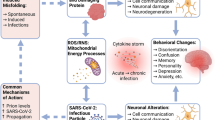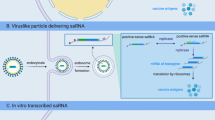Summary
1. Vaccination-induced anti-prion protein antibodies are presently regarded as a promising approach toward treatment of prion diseases. Here, we investigated the ability of five peptides corresponding to three different regions of the bovine prion protein (PrP) to elicit antibodies interfering with PrPSc propagation in prion-infected cells.
2. Rabbits were immunized with free nonconjugated peptides. Obtained immune sera were tested in enzyme-linked immunosorbent assay (ELISA) and immunoblot for their binding to recombinant PrP and cell-derived pathogenic isoform (PrPSc) and normal prion protein (PrPc), respectively. Sera positive in all tests were chosen for PrPSc inhibition studies in cell culture.
3. All peptides induced anti-peptide antibodies, most of them reacting with recombinant PrP. Moreover, addition of the serum specific to peptide 95–123 led to a transient reduction of PrPSc levels in persistently prion-infected cells.
4. Thus, anti-PrP antibodies interfering with PrPSc propagation were induced with a prion protein peptide nonconjugated to a protein carrier. These results point to the potential application of the nonconjugated peptide 95–123 for the treatment of prion diseases.




Similar content being viewed by others
REFERENCES
Aguzzi, A., and Polymenidou, M. (2004). Mammalian prion biology: One century of evolving concepts. Cell 116:1–15.
Brennan, F. R., and Dougan, G. (2005). Non-clinical safety evaluation of novel vaccines and adjuvants: new products, new strategies. Vaccine 23:3210–3222.
Enari, M., Flechsig, E., and Weissmann, C. (2001). Scrapie prion protein accumulation by scrapie infected neuroblastoma cells abrogated by exposure to a prion protein antibody. Proc. Natl. Acad. Sci. USA 98:9295–9299.
Ertmer, A., Gilch, S., Yun, S. W., Flechsig, E., Klebl, B., Stein-Gerlach, M., Klein, M. A., and Schatzl, H. M. (2004). The tyrosine kinase inhibitor STI571 induces cellular clearance of PrPSc in prion-infected cells. J. Biol. Chem. 279:41918–41927.
Feraudet, C., Morel, N., Simon, S., Volland, H., Frobert, Y., Creminon, C., Vilette, D., Lehmann, S., and Grassi, J. (2005). Screening of 145 anti-PrP monoclonal antibodies for their capacity to inhibit PrPSc replication in infected cells. J. Biol. Chem. 280:11247–11258.
Fernandez-Escamilla, A.-M., Rousseau, F., Schymkowitz, J., and Serrano, L. (2004). Prediction of sequence-dependent and mutational effects on the aggregation of peptides and proteins. Nat. Biotech. 22:1302–1306.
Forloni, G., Angeretti, N., Chiesa, R., Monzani, E., Salmona, M., Bugiani, O., and Tagliavini, F. (1993). Neurotoxicity of a prion protein fragment. Nature 362(6420):543–546.
Gilch, S., Winklhofer, K. F., Groschup, M. H., Nunziante, M., Lucassen, R., Spielhaupter, C., Muranyi, W., Riesner, D., Tatzelt, J., and Schatzl, H. M. (2001). Intracellular re-routing of prion protein prevents propagation of PrPSc and delays onset of prion disease. EMBO J. 20:3957–3966.
Gilch, S., Wopfner, F., Renner-Muller, I., Kremmer, E., Bauer, C., Wolf, E., Brem, G., Groschup, M. H., and Schatzl, H. M. (2003). Polyclonal anti-PrP auto-antibodies induced with dimeric PrP interfere efficiently with PrPSc propagation in prion infected cells. J. Biol. Chem. 278:18524–18531.
Kretzschmar, H. A., Prusiner, S. B., Stowring, L. E., and DeArmond, S. J. (1986). Scrapie prion proteins are synthesized in neurons. Am. J. Pathol. 122:1–5.
Long, J. R., Tang, L. M., Qiu, X. P., Zeng, F. T., Xie, X. H., and Zhang, Y. P. (2004). Sequence variation in the rabbit major histocompatibility complex DQA gene. Proceedings of the 8th World Rabbit Congress, Puebla, Mexico: 96–101.
Magri, G., Clerici, M., Dall’Ara, P., Biasin, M., Caramelli, M., Casalone, C., Giannino, M. L., Longhi, R., Piacentini, L., Della Bella, S., Gazzuola, P., Martino, P. A., Della Bella, S., Pollera, C., Puricelli, M., Servida, F., Crescio, I., Boasso, A., Ponti, W., and Poli, G. (2005). Decrease in pathology and progression of scrapie after immunization with synthetic prion protein peptides in hamsters. Vaccine 23:2862–2868.
Nunziante, M., Gilch, S., and Schatzl, H. M. (2003). Prion diseases: From molecular biology to intervention strategies. Chem. Bio. Chem. 4:1268–1284.
Peretz, D., Williamson, R. A., Kaneko, K., Vergara, J., Leclerc, E., Schmitt-Ulms, G., Mehlhorn, I. R., Legname, G., Wormald, M. R., Rudd, P. M., Dwek, R. A., Burton, D. R., and Prusiner, S. B. (2001). Antibodies inhibit prion propagation and clear cell cultures of prion infectivity. Nature 412:739–743.
Perrier, V., Solassol, J., Crozet, C., Frobert, Y., Mourton-Gilles, C., Grassi, J., and Lehmann, S. (2004). Anti-PrP antibodies block PrPSc replication in prion-infected cell cultures by accelerating PrPc degradation. J. Neurochem. 89:454–463.
Polymenidou, M., Heppner, F. L., Pellicioli, E. C., Urich, E., Miele, G., Braun, N., Wopfner, F., Schatzl, H. M., Becher, B., and Aguzzi, A. (2004). Humoral immune response to native eukaryotic prion protein correlates with anti-prion protection. Proc. Natl. Acad. Sci. USA 101:14670–14676.
Proske, D., Gilch, S., Wopfner, F., Schatzl, H. M., Winnacker, E. L., and Famulok, M. (2002). Prion-Protein-Specific Aptamer Reduces PrPSc Formation. Chem. Bio. Chem. 3:717–725.
Prusiner, S. B. (1997). Prion diseases and the BSE crisis. Science 278:245–251.
Rymer, D. L., Good, T. A. (2000). The role of prion peptide structure and aggregation in toxicity and membrane binding. J. Neurochem. 75(6):2536–2545.
Schwarz, A., Kratke, O., Burwinkel, M., Riemer, C., Schultz, J., Henkleinb, P., Bammea, T., and Baier, M. (2003). Immunization with a synthetic prion protein-derived peptide prolongs survival times of mice orally exposed to the scrapie agent. Neurosci. Lett. 350:187–189.
Sette, A., and Fikes, J. (2003). Epitope-based vaccines: an update on epitope identification, vaccine design and delivery. Curr. Opin. Immunol. 15:461–470.
Sigurdsson, E. M., Brown, D. R., Daniels, M., Kascsak, R. J., Kascsak, R., Carp, R., Meeker, H. C., Frangione, B., and Wisniewski, T. (2002). Immunization delays the onset of prion disease in mice. Am. J. Pathol. 161:13–17.
Souan, L., Tal, Y., Felling, Y., Cohen, I. R., Taraboulos, A., and Mor, F. (2001). Modulation of proteinase-K resistant prion protein by prion peptide immunization. Eur. J. Immunol. 31:2338–2346.
Tagliavini, F., Prelli, F., Verga, L., Giaccone, G., Sarma, R., Gorevic, P., Ghetti, B., Passerini, F., Ghibaudi, E., and Forloni, G. (1993). Synthetic peptides homologous to prion protein residues 106-147 form amyloid-like fibrils in vitro. Proc. Natl. Acad. Sci. 90(20):9678–9682.
Tal, Y., Souan, L., Cohen, I. R., Meiner, Z., Taraboulos, A., and Mor, F. (2003). Complete Freund's adjuvant immunization prolongs survival in experimental prion disease in mice. J. Neurosci. Res. 71:286–290.
Udenfriend, S., and Meienhoferm, J. (1987). The peptides: Analysis, synthesis and biology, vol. 9, Academic Press, London.
White, A. R., Enever, P., Tayebi, M., Mushens, R., Linehan, J., Brandner, S., Anstee, D., Collinge, J., and Hawke, S. (2003). Monoclonal antibodies inhibit prion replication and delay the development of prion disease. Nature 422:80–83.
Ziegler, J., Viehrig, C., Geimer, S., Rosch, P., and Schwarzinger, S. (2006). Putative aggregation initiation sites in prion protein. FEBS Lett. 580(8):2033–2040.
ACKNOWLEDGMENTS
We thank Elke Maas and Dr. Alexa Ertmer for their help and advice, Dr. Max Nunziante, Gunnar Schulz and Dr. Ina Vorberg for helpful discussions and ideas. Maria Oboznaya was an exchange scientist sponsored by the DAAD. This work was supported in part by the European Union (NoE NeuroPrion), the Bavarian Government (LMU5*), and by the BMBF (01KO0108).
Author information
Authors and Affiliations
Corresponding author
Rights and permissions
About this article
Cite this article
Oboznaya, M.B., Gilch, S., Titova, M.A. et al. Antibodies to a Nonconjugated Prion Protein Peptide 95-123 Interfere with PrPSc Propagation in Prion-Infected Cells. Cell Mol Neurobiol 27, 271–284 (2007). https://doi.org/10.1007/s10571-006-9108-y
Received:
Accepted:
Published:
Issue Date:
DOI: https://doi.org/10.1007/s10571-006-9108-y




